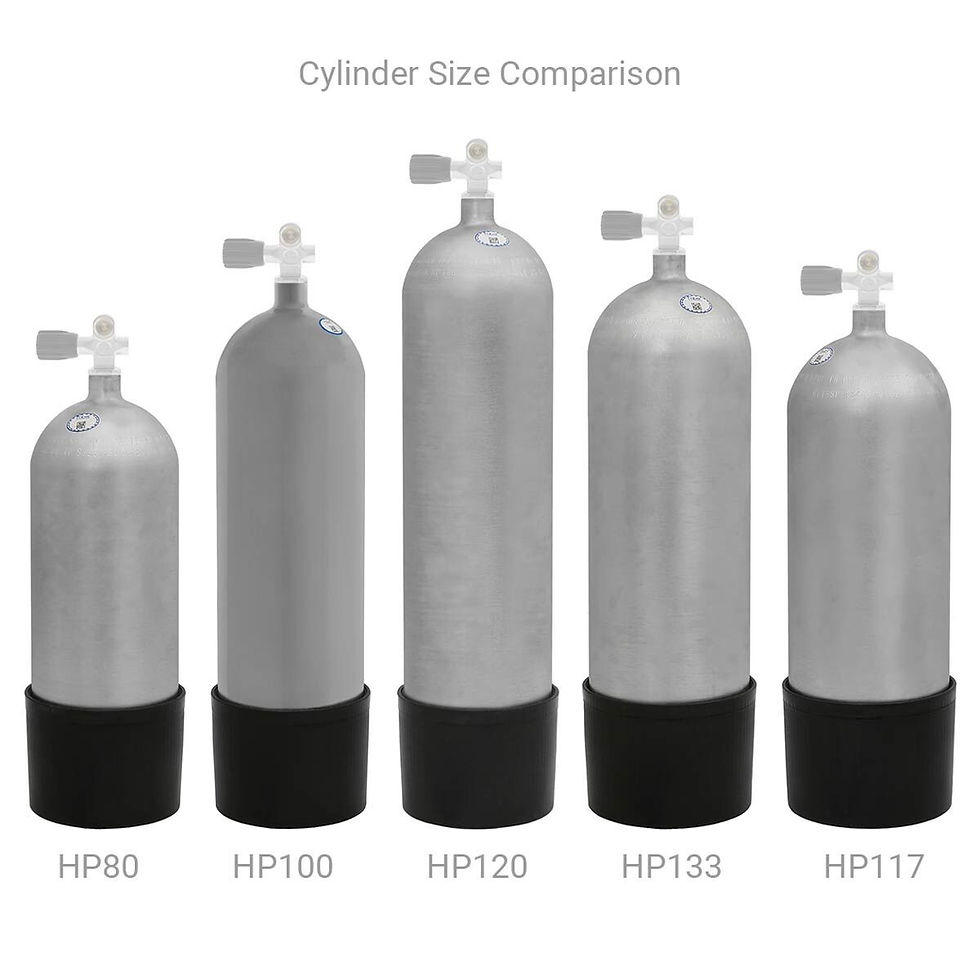A beginners Guide to Scuba Tanks
- Chris Dailey
- Sep 11
- 4 min read

How to Choose the Right Scuba Tank Size
So, there I was at 82 ft on the Lady Luck and suddenly, I get a vibration on my Shearwater Peregrine Dive Computer. Reserve tank pressure Alert….. I’m now at 700 psi and my fun dive now turns into a mad dash to my safety stop at 20 ft.
No one wants to cut their dives short because of low air. The scuba tank you choose plays a huge role in this. Picking the right size can mean the difference between a relaxed adventure and an early end to your dive. So, let’s strap on our virtual fins and dive into the essentials of scuba tank sizing, pressure, and maintenance.
Scuba Tank Basics: More Than Just a Metal Cylinder
Your tank isn’t just a chunk of metal—it’s your lifeline underwater. Understanding a few key concepts will help you make smarter gear choices:
Pressure (psi): Measured in pounds per square inch, this tells you how much air is compressed into your tank. Keep in mind though that more psi doesn’t always mean more air. A smaller tank at higher pressure may still hold less air than a larger tank at lower pressure.
Tank Size (cubic feet): This indicates how much air the tank holds at its rated pressure. Common sizes include 50 – 63, 80, 100, 117 and 120 cubic feet. With the Aluminum 80 being the most popular for recreational diving due to its balance of air capacity, buoyancy, and cost. Bigger tanks hold more air but are also heavier. Something to keep that in mind when choosing a tank.
Tank Material: Most tanks are made of aluminum or steel.
Aluminum is lighter and more buoyant, often requiring extra weight to offset.
Steel is heavier but less buoyant, meaning you may carry less weight, which to me is a huge benefit.
Both are reliable—it’s largely about personal preference and dive style as to which will suit you best.

Tank Maintenance: Keeping Your Lifeline Safe
A well-maintained tank is a safe tank. Just like you wouldn’t drive a rusty old car on a long road trip, you shouldn’t dive with a poorly maintained cylinder.
Two key safety checks:
Visual Inspection:
Before every dive, look for corrosion, dents, cracks, or other visual damage.
Check the O-ring and valve threads and confirm the inspection date on the tank.
Tanks should undergo a professional visual inspection every year.
Hydrostatic Testing:
This test pressurizes the tank with water beyond its working pressure to ensure structural integrity.
Required every five years by the DOT, it helps catch hidden weaknesses before they become dangerous.
Routine inspections and hydro tests aren’t just maintenance—they’re your assurance that your tank will perform when it matters most.
Pressure and Volume: The Underwater Tango
Tank pressure and volume are like dance partners—closely connected.
Baseline: The baseline tells you how many cubic feet your tank holds per psi.
Example: An 80-cu ft tank at 3000 psi has a baseline of 0.0267 cu ft/psi.
Why it matters:
As you breathe and descend, pressure inside the tank drops even though the amount of air stays the same.
A small tank at 3500 psi might not hold as much air as a larger tank at 3000 psi.
Tank Size | Pressure | Air Volume at 3000 psi | Air Volume at 2000 psi | Air Volume at 1000 psi |
80 cu ft | 3442 psi | 69 cu ft | 46 cu ft | 23 cu ft |
80 cu ft | 3000 psi | — | 46 cu ft | 23 cu ft |
85 cu ft | 2640 psi | — | 51 cu ft | 25.5 cu ft |
These numbers are an estimate, and your actual consumption depends on depth, experience, and breathing rate.
How to Choose the Right Tank Size
Finding the right tank is like finding your perfect dive buddy—it needs to match your style and pace.
Consider these factors:
Air Consumption: Newer drivers typically breathe faster and use more air.
Dive Depth: Deeper dives = more air consumption.
Bottom Time: Longer dives require more air—or multiple tanks.
Comfort and Fitness: Larger tanks can be heavy. Make sure you’re comfortable carrying and maneuvering your gear.
Safety Buffer: Always plan extra air for unexpected currents, longer safety stops, or buddy emergencies.
Rule of Thumb: Many divers plan for roughly 1 cubic foot of air per minute at the surface. Adjust for your own SAC (Surface Air Consumption) rate and dive profile.
The Rule of Thirds: Your Built-In Safety Net
Safety is everything in scuba diving. The Rule of Thirds is a simple, time-tested method for managing your air:
First third: For your descent and bottom time.
Second third: For your ascent and safety stop.
Final third: Reserved strictly for emergencies.
For example, if you start with 3000 psi, begin your ascent when your SPG reads around 2000 psi. That leaves 1000 psi for your ascent and as an emergency reserve.
Of course, this rule can be adjusted for different dive profiles—deep or decompression dives may require a larger reserve.
Final Tips for New Divers
Try Before You Buy: Rent different tank sizes to find what feels best.
Match Your Buddy: Similar tank sizes help keep air consumption aligned.
Ask the Pros: Your local dive shop or instructor can give personal recommendations.
Choosing the right scuba tank isn’t just about numbers—it’s about matching your gear to your diving style and keeping yourself safe underwater. With the right tank on your back, you’ll spend less time worrying about your air supply and more time enjoying the magic beneath the surface.




Comments